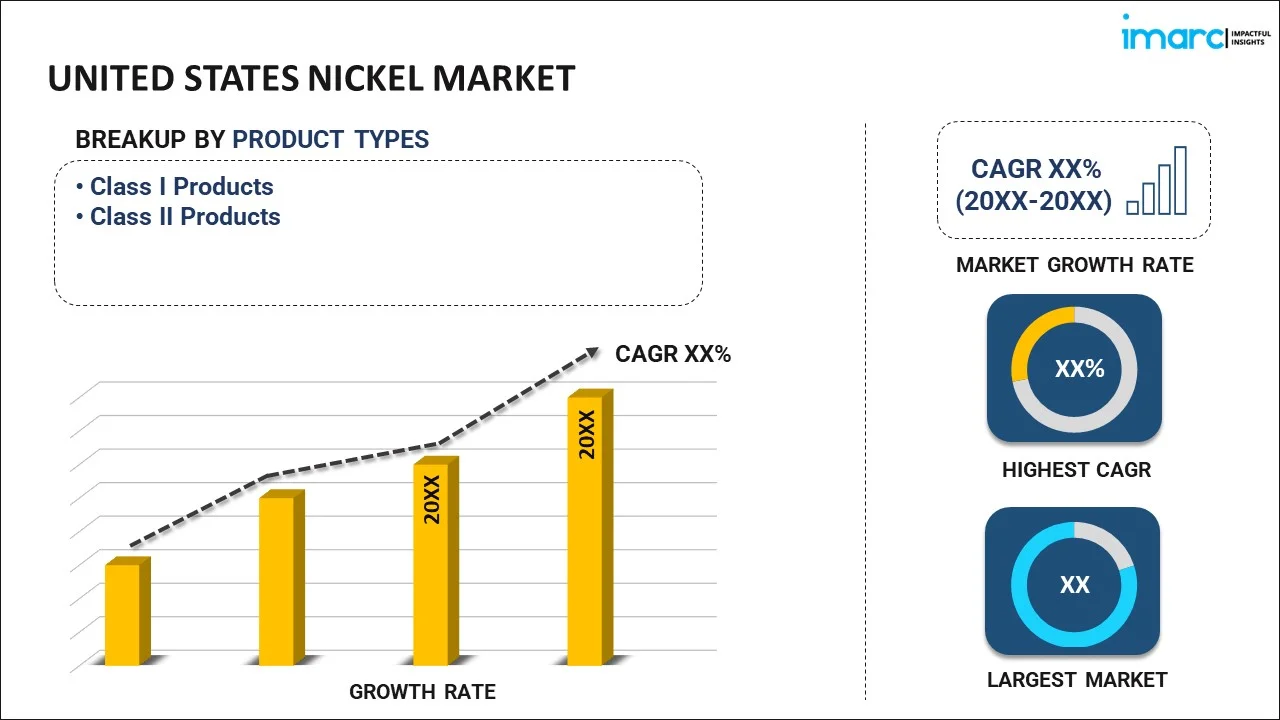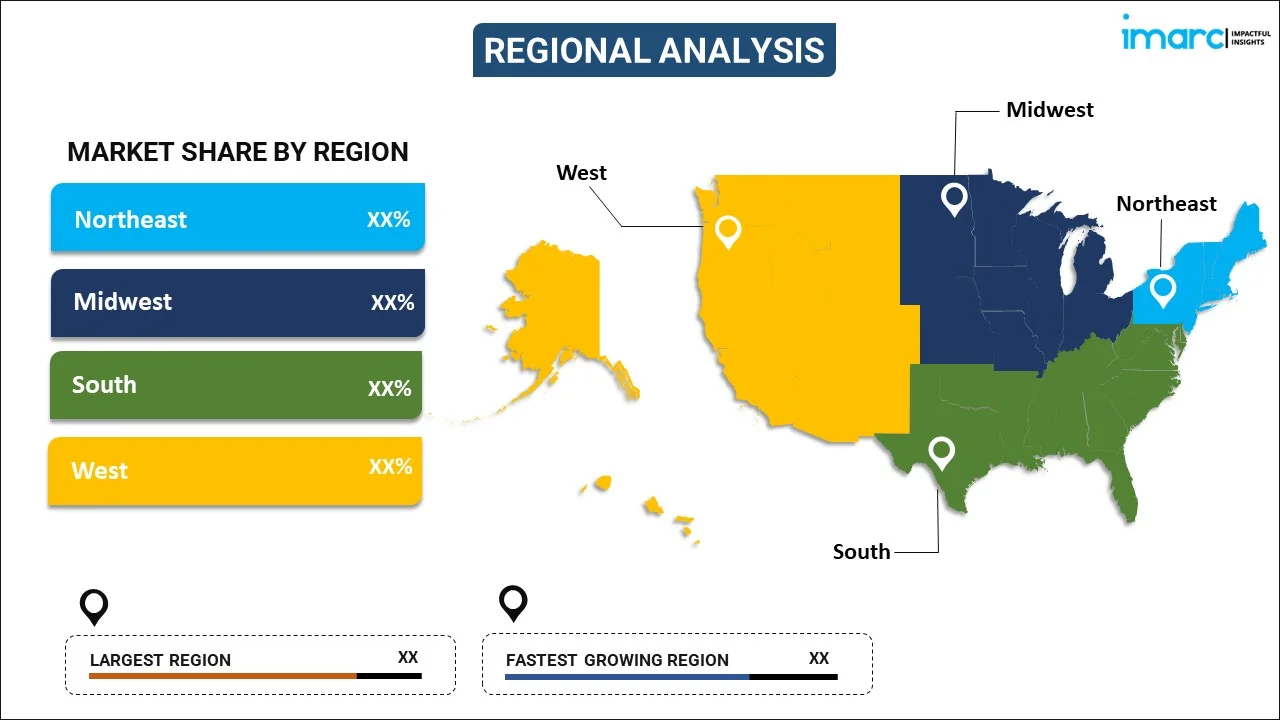
United States Nickel Market Report by Product Type (Class I Products, Class II Products), Application (Stainless Steel and Alloy Steel, Non- Ferrous Alloys and Superalloys, Electroplating, Casting, Batteries, and Others), End Use Industry (Transportation and Defense, Fabricated Metal Products, Electrical and Electronics, Chemical, Petrochemical, Construction, Consumer Durables, Industrial Machinery, and Others), and Region 2025-2033
Market Overview:
The United States nickel market size reached USD 11.3 Billion in 2024. Looking forward, IMARC Group expects the market to reach USD 15.6 Billion by 2033, exhibiting a growth rate (CAGR) of 3.6% during 2025-2033. The increasing demand for nickel in the electric vehicle (EV) industry, widespread adoption of nickel in construction, infrastructure, and consumer goods, and ongoing advancements in battery technologies are some of the key factors driving the market.
|
Report Attribute
|
Key Statistics
|
|---|---|
|
Base Year
|
2024 |
|
Forecast Years
|
2025-2033
|
|
Historical Years
|
2019-2024
|
| Market Size in 2024 | USD 11.3 Billion |
| Market Forecast in 2033 | USD 15.6 Billion |
| Market Growth Rate (2025-2033) | 3.6% |
Nickel is a transition metal that exhibits unique properties, making it a valuable commodity in various industries. It is known for its exceptional resistance to corrosion, making it an essential component in stainless steel production. It is widely utilized in manufacturing stainless steel, which is extensively employed in construction, transportation, and kitchen utensils. It also plays a critical role in the production of various alloys, such as nickel copper, cupronickel and nickel-chromium, including Nichrome. Moreover, nickel has gained significance in the expanding electric vehicle industry as it is utilized in the production of rechargeable batteries, specifically nickel-metal hydride (NiMH) and nickel-cadmium (NiCd) batteries, which offer high energy storage capacities. Additionally, nickel-based catalysts are employed in the petrochemical industry to enhance various chemical reactions.
United States Nickel Market Trends:
The increasing demand for nickel in the electric vehicle (EV) industry is driving the market in United States. Nickel plays a crucial role in the production of lithium-ion batteries, which power most electric vehicles. As the world moved toward cleaner and more sustainable transportation solutions, the demand for EVs increased, leading to a corresponding rise in nickel consumption. This trend was further accelerated by government incentives and regulations favoring electric mobility in various countries, stimulating the expansion of the EV market. Moreover, the growth of the stainless steel industry is catalyzing the market as nickel is a key component of stainless steel, which is widely used in construction, infrastructure, and consumer goods. As economies continued to recover and expand, the demand for stainless steel increased, driving up the need for nickel as well. Furthermore, technological developments in nickel mining and extraction processes were significant drivers. Innovations in mining technologies and extraction methods could enhance the overall supply chain efficiency and potentially influence market dynamics. Ongoing advancements in battery technologies, particularly in the development of next-generation batteries, such as solid-state batteries, could alter the demand for nickel. Increased focus on sustainability and circular economy practices could boost the importance of nickel recycling, affecting the need for primary nickel production. Environmental policies and regulations could impact the nickel market in several ways. Stricter emissions standards or regulations promoting clean energy and electric vehicles can augment the demand for nickel in battery technologies. On the other hand, environmental restrictions on mining or processing could affect the supply side. Extreme weather events or natural disasters can disrupt mining, transportation, and production operations, affecting the supply of nickel. The health and performance of industries that heavily rely on nickel, such as aerospace, chemical processing, and electronics, can influence nickel demand. Growth or contraction in these sectors can impact the overall demand for nickel products.
United States Nickel Market Segmentation:
IMARC Group provides an analysis of the key trends in each segment of the United States nickel market report, along with forecasts at the country level for 2025-2033. Our report has categorized the market based on product type, application, and end use industry.
Product Type Insights:

- Class I Products
- Class II Products
The report has provided a detailed breakup and analysis of the United States nickel market based on the product type. This includes class I products and class II products.
Application Insights:
- Stainless Steel and Alloy Steel
- Non-Ferrous Alloys and Superalloys
- Electroplating
- Casting
- Batteries
- Others
A detailed breakup and analysis of the United States nickel market based on the application has also been provided in the report. This includes stainless steel and alloy steel, non- ferrous alloys and superalloys, electroplating, casting, batteries, and others.
End Use Industry Insights:
- Transportation and Defense
- Fabricated Metal Products
- Electrical and Electronics
- Chemical
- Petrochemical
- Construction
- Consumer Durables
- Industrial Machinery
- Others
A detailed breakup and analysis of the United States nickel market based on the end use industry has also been provided in the report. This includes transportation and defense, fabricated metal products, electrical and electronics, chemical, petrochemical, construction, consumer durables industrial machinery and others.
Regional Insights:

- Northeast
- Midwest
- South
- West
The report has also provided a comprehensive analysis of all the major regional markets, which include Northeast, Midwest, South, and West.
Competitive Landscape:
The report has also provided a comprehensive analysis of the competitive landscape in the United States nickel market. Competitive analysis such as market structure, key player positioning, top winning strategies, competitive dashboard, and company evaluation quadrant has been covered in the report. Also, detailed profiles of all major companies have been provided.
United States Nickel Market Report Coverage:
| Report Features | Details |
|---|---|
| Base Year of the Analysis | 2024 |
| Historical Period | 2019-2024 |
| Forecast Period | 2025-2033 |
| Units | Billion USD |
| Scope of the Report | Exploration of Historical and Forecast Trends, Industry Catalysts and Challenges, Segment-Wise Historical and Predictive Market Assessment:
|
| Product Types Covered | Class I Products, Class II Products |
| Applications Covered | Stainless Steel and Alloy Steel, Non- Ferrous Alloys and Superalloys, Electroplating, Casting, Batteries, Others |
| End Use Industries Covered | Transportation and Defense, Fabricated Metal Products, Electrical and Electronics, Chemical, Petrochemical, Construction, Consumer Durables, Industrial Machinery, Others |
| Regions Covered | Northeast, Midwest, South, West |
| Customization Scope | 10% Free Customization |
| Post-Sale Analyst Support | 10-12 Weeks |
| Delivery Format | PDF and Excel through Email (We can also provide the editable version of the report in PPT/Word format on special request) |
Key Questions Answered in This Report:
- How has the United States nickel market performed so far and how will it perform in the coming years?
- What has been the impact of COVID-19 on the United States nickel market?
- What is the breakup of the United States nickel market on the basis of product type?
- What is the breakup of the United States nickel market on the basis of application?
- What is the breakup of the United States nickel market on the basis of end use industry?
- What are the various stages in the value chain of the United States nickel market?
- What are the key driving factors and challenges in the United States nickel market?
- What is the structure of the United States nickel market and who are the key players?
- What is the degree of competition in the United States nickel market?
Key Benefits for Stakeholders:
- IMARC’s report offers a comprehensive quantitative analysis of various market segments, historical and current market trends, market forecasts, and dynamics of the United States nickel market from 2019-2033.
- The research study provides the latest information on the market drivers, challenges, and opportunities in the United States nickel market.
- Porter's five forces analysis assist stakeholders in assessing the impact of new entrants, competitive rivalry, supplier power, buyer power, and the threat of substitution. It helps stakeholders to analyze the level of competition within the United States nickel industry and its attractiveness.
- Competitive landscape allows stakeholders to understand their competitive environment and provides an insight into the current positions of key players in the market.
Need more help?
- Speak to our experienced analysts for insights on the current market scenarios.
- Include additional segments and countries to customize the report as per your requirement.
- Gain an unparalleled competitive advantage in your domain by understanding how to utilize the report and positively impacting your operations and revenue.
- For further assistance, please connect with our analysts.
 Inquire Before Buying
Inquire Before Buying
 Speak to an Analyst
Speak to an Analyst
 Request Brochure
Request Brochure
 Request Customization
Request Customization




.webp)




.webp)












